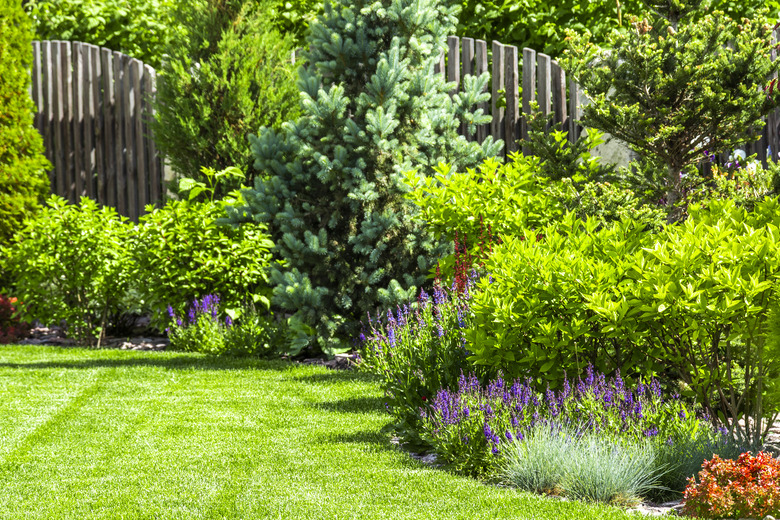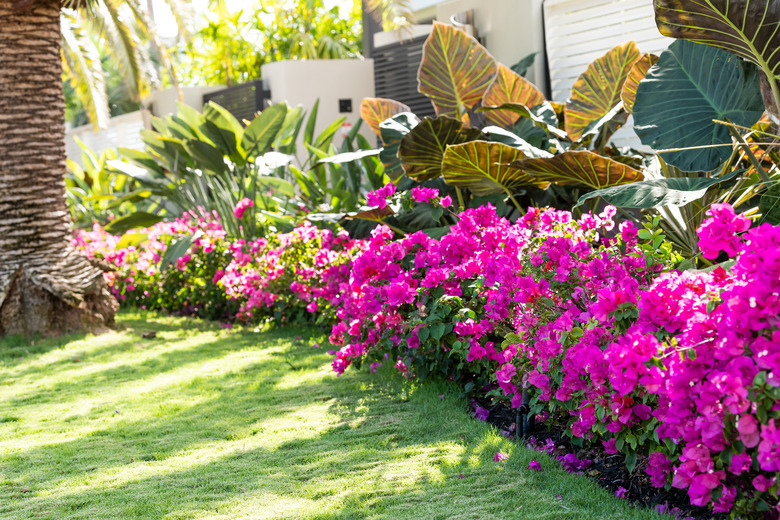Safe And Natural Weed Control In The Garden
We may receive a commission on purchases made from links.
Few things are more frustrating than spending hours lovingly planting and painstakingly caring for new plants only to find that your garden is overrun with weeds a few weeks later. While some people might immediately turn to aggressive chemical herbicides, many forms of natural weed control are just as effective, and they are a lot safer for the environment and the other plants in your garden beds (and in the case of vegetable gardens, safer for you). Maintaining a weed-free garden can be difficult at first, but as the weeds die off and are stopped from spreading, it will become easier every successive year.
Recognizing Different Weed Types
Recognizing Different Weed Types
When determining the right method of weed control for your garden, it's important to identify the type of weed you're trying to eliminate. That's because different garden weeds require different control strategies.
Annual Weeds
Annual weeds are those that germinate, flower, seed and die within a single growing season. These spread by seed, with a new batch of weeds sprouting the following year. Winter annuals are killed off by summer heat, and summer annuals are killed off by fall frosts. Examples include crabgrass, knotweed, annual bluegrass, shepherd's purse, purslane and common chickweed. These are the easiest weeds to eliminate because if their seeds are unable to spread and germinate, they will not return. They can be controlled by pulling, cultivating and mulching and through the use of nontoxic herbicides.
Biennial Weeds
Biennial weeds live for two years, flowering and spreading seeds in their second year. These often have long taproots that allow them to store energy when they die off in the winter so they can return the following year and go to seed. Examples include burdock, Queen Anne's lace and common mullein. Biennials are harder to kill than annuals because their taproot must be destroyed to prevent them from returning and going to seed. That being said, they still only spread by seed, and their two-year life cycle ensures they are easier to eliminate than most perennials. Mulching, cultivating and using preemergent herbicides can help stop them from germinating.
Perennial Weeds
Many perennial weeds have taproots that allow them to survive through the winter so they can grow back the following year, only these plants survive year after year. In fact, because they can flower and seed every year, they can easily take over an area when left unchecked. Common perennial weeds include dandelions, plantains and chickory, which are easiest to kill during their first year before they have become established. Once established, you must kill off the whole root system in order to destroy the plants, but the good news is that they can still only reproduce if they are allowed to go to seed. This means mulches and preemergent herbicides can be good deterrents to the plant's reproduction.
Rhizomatous Weeds
Rhizomatous weeds are perennials that are spread both by seed and through horizontal stems that grow just above or just below the soil surface. These weeds spread quickly and efficiently and can be particularly difficult to eliminate because it can be hard to kill all the rhizomes before the plants have a chance to spread. Some notably unpleasant weeds are rhizomatous, including poison ivy, stinging nettle and poison oak, but even those that are not irritating to the skin are still notably hard to kill, with bindweed and kudzu serving as two notable examples.
The best technique to kill off rhizomatous weeds is to solarize the soil in order to eliminate them completely before planting. If you notice a rhizomatous weed sprouting in your existing garden, it is important to remove it as soon as possible before it has a chance to take hold and spread.
Design Your Garden for Success
Design Your Garden for Success
When planting your garden, incorporate weed-prevention concepts in the layout. This means designing it in a way that reduces the amount of empty spaces for weeds to take hold. Start by choosing fungal-disease-resistant plants, as they can be spaced a little closer together than other varieties with less risk of infection. Choose plants that grow at different heights, including some cover crops, to help reduce sun exposure on the soil, making it more difficult for seeds to get the sunlight they need to germinate.
Pull Weeds by Hand
Pull Weeds by Hand
Hand-pulling weeds is most effective with annuals because their root systems tend to be particularly delicate since they do not need to survive more than a year. For biennials and perennials, hand-weeding is most effective when the weed is young and not yet fully established. Once a biennial or perennial weed is fully grown, failure to remove the whole root could result in it growing back again or, in the case of rhizomatous weeds, even continuing to reproduce. This means that if you aren't sure whether or not you're removing annual weeds, it's important to carefully dig around the weed's base so you can expose and remove all of the connecting roots.
For weed removal, you might want to use a weeder tool, but a claw, sharp trowel or even a screwdriver can also be helpful in digging up soil and loosening roots. It's also a good idea to wear gloves to protect your hands from spikes and blisters but be sure to choose a dedicated pair of gardening gloves for this job or clean the gloves well after use to avoid transferring seeds when doing other tasks in the garden.
While weeding should be done as needed, it's important to pull weeds before they go to seed, so it's best to be particularly vigilant in early spring. The best time to weed is just after a rain so the soil is nice and moist. If you notice weeds that are starting to flower and you don't have time to weed right then, you can at least prevent their spread by cutting off the flowers with scissors or a hand scythe to disallow the blooms from producing seeds.
Use Mulch for Weed Control
Use Mulch for Weed Control
Mulching is one of the best natural solutions to prevent weeds and a great way to retain moisture in your soil. A thick layer of mulch prevents sunlight from reaching the soil, making it harder for seeds to germinate, although some weed seeds may germinate in the mulch itself.
That being said, not every mulch is good for weed control. Stay away from organic matter that hasn't been properly composted, particularly grass clippings and hay mulch, because these may actually have weed seeds in them. Instead, look for organic mulches from reliable sources, such as commercially produced compost or wood chips, or use your own compost as long as it has been properly broken down. For best results, avoid putting weeds in your compost bin.
When using mulch, only apply it in areas that have already been weeded because many established weeds can't simply be smothered with mulch. Apply it early in the season before weeds begin to germinate, and apply a new layer around any new plants as soon as you place them in the garden. Remember to check the levels regularly to ensure you have enough mulch and replenish it as needed. Try to maintain a 3-inch layer of mulch, as applying too much mulch can make it difficult for air and water to effectively get to the soil.
In areas with serious weed problems, particularly if you have a problem with weeds that spread via rhizomes, it can be useful to apply a barrier layer prior to mulching, though you may still find clumps of weeds around the gaps. This can be done with around 10 sheets of wet newspaper (don't use glossy pages) or standard landscape fabric. Lay the barrier on the soil after weeding but before mulching. You can easily cut a hole through these materials to make room for new plantings. At the end of the season, newspaper will be broken down and incorporated into the soil. Landscaping fabric should be removed at the end of the season since it can diminish soil health over time. However, it's worth remembering that the number of weeds you have will go down every year with proper prevention methods.
Cultivate the Soil
Cultivate the Soil
Cultivating can be an effective way to eliminate annual or biennial weeds by cutting down weedlings as soon as possible so they do not have an opportunity to go to seed. Chopping down young weeds and gently tilling them under the soil where they can be left to decompose and enrich the soil is an effective technique to eliminate weeds in empty rows in your vegetable garden. A hoe or rotary cultivator can be useful for this purpose, but be careful not to get too close to your plants, particularly with something large like a rotary cultivator.
When cultivating, it's best to avoid digging too deeply, as this can help increase germination of weed seeds already in the soil. Also, you do not want to damage the roots of the plants in your garden.
While there are tons of "natural" herbicide recipes available online, many of these rely on vinegar, borax, salt or other substances that can end up harming your soil long after they kill off the weeds. As a result, these should be avoided.
Solarize Your Soil Prior to Planting
Solarize Your Soil Prior to Planting
If all else fails and you find you just can't eliminate your weed problem, you can always use the nuclear option: solarizing your soil. This method is one of the most effective ways to kill weeds, but it is also tough on your soil since it kills all beneficial organisms and bacteria by causing your soil to reach temperatures of up to 120 degrees Fahrenheit. This means you'll need to till in organic compost to restore your soil's health after the process is completed. It will also kill off any existing plants in your garden, so it's only a good solution if you are willing to sacrifice any good plants that you do have.
If you have a serious rhizomatous weed infestation in your yard, though, solarization may be the most effective way to eliminate the problem before planting. This technique is less effective on sandy soil because it does not hold sufficient moisture to create enough steam. You'll need to wait until the middle of summer to ensure you'll get enough sunlight and heat to sterilize your soil, which also means you won't be able to grow any new plants until it's done, so the soonest you can start growing will be in fall.
To solarize your soil, first mow as close to the soil as possible and then rake up all remaining plant matter. Till the soil to a depth of 5 to 8 inches and take care to remove any large root clusters or any other debris. Water the soil until it is fully saturated and then cover the area with clear plastic that is 1 to 4 mils thick (black or white plastic will not allow enough sunlight to reach the soil). Secure the edges of the plastic by burying it a few inches deep or by laying bricks or other heavy materials around the entire edge.

